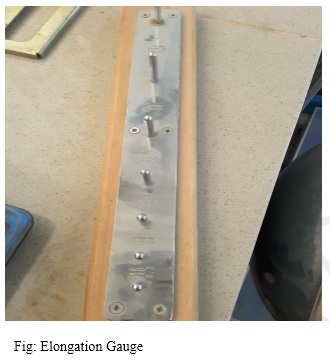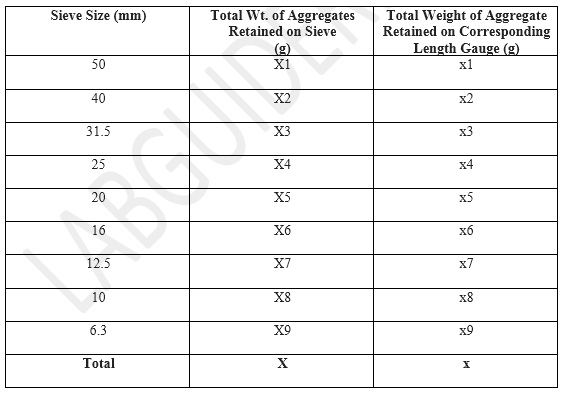Elongation Index Test
Introduction
Elongation test and Flakiness tests are known as Shape Tests and are performed on aggregate. The Elongation test is discussed in this procedure.
Click Here to go to Flakiness Test
Elongation index of an aggregate is the percentage by weight of particles whose greatest dimension (length) is greater than one and four-fifth times their mean dimension. It is measured on particles passing through mesh size of 63mm and retained on mesh size of 6.3mm. Determination of elongation index of coarse aggregate is explained below.
Significance of Flakiness & Elongation Index
• The degree of packing of the particles of one size depends upon their shape.
• Due to high surface area to volume ratio, the flaky and elongated particles lower the workability of concrete mixes.
• Flaky and elongated particles are considered undesirable for base coarse construction as they may cause weakness with possibilities of braking down under heavy loads.
• BS-1241 specifies a Flakiness index not exceeding 30% irrespective of the aggregate size.
• Maximum permitted Elongated index is 35, 40 or 45% for aggregate sizes 2 ½’’ – 2’’, 1 ½’’ – ¾’’ & ½’’ – 3/8’’.
• Both Flakiness and Elongation tests are not applicable to sizes smaller then 6.3mm i.e. ¼’’ sieve.
Objective(s) of the Experiment
This test is carried out to determine the elongation index of aggregates
Apparatus Needed
Apparatus required for elongation index determination tests are:
1. Weighing Balance
2. Elongation Gauge (Length Gauge)
3. IS sieves of the following mesh sizes – 63mm, 50mm, 40mm, 31.5mm, 25mm, 20mm, 16mm, 12.5mm, 10mm and 6.3mm.

Procedures
1. Take enough quantity of dry blended sample so that at least 200 pieces of any fraction is present. This is not applicable for the biggest and smallest size.
2. Sieve the blended sample through all the sieves mentioned above starting from the largest sieve i.e. 63mm.
3. Note the fraction of the particles of size ranges of – 63mm to 50mm, 50mm to 40mm, 40mm to 31.5mm, 31.5mm to 25mm, 25mm to 20mm, 20mm to 16mm. 16mm to 12.5mm. 12.5mm to 10mm and 10mm to 6.3mm through the particles retained on the lower sieve sizes (shown on the recording sheet below). Weigh each of these say (X1, X2, X3, X4….) and record in your sheet. The summation is X.
4. Take all the fraction separately, gauge them one by one, passing them through the corresponding slot provided in the length gauge. Keep the particles retained by the length separately. The aim should be to retain as much as possible to avoid testing bias.
5. Weigh the particles retained on each length gauge as x1, x2, x3, x4… The summation is x.
6. Elongation index is the total weight of the material retained on the various length gauges, expressed as a percentage of the total weight of the sample gauged.
Results and Calculations
The sample of the recording sheet is shown below:

Elongation index of aggregate in % is calculated as follows:
 Where,
Where,
x = weight of particles retained in length gauge (grams).
X= weight of total sample taken for test (grams).
Precautions
1. While sieving, care must be taken that the particles that are chocked in the sieve must not be forced down into the next sieve. Such particles should be pushed back into the same sieve.
2. While placing different fractions on the table, place them some distance apart so that no two fractions may get mixed.
3. Be careful while selecting the opening of the flakiness and elongation gauges for any particular fraction.
Discussion and Conclusion
• Report the elongation index in percentage rounded off to the nearest whole number.
• For determination of Elongation index of coarse aggregate as per BS code, check BS812: – Section 105.2
Credits: Samuel Alalade. Obafemi Awolowo University, Ile-Ife, Osun State, Nigeria.
